One-Wall Kitchen Layouts: The Essential Do's and Don'ts
In today's design-savvy world, the one-wall kitchen layout is rapidly gaining traction as a go-to choice for small homes and apartments. With its streamlined design that tucks everything neatly along a single wall, this layout offers a perfect blend of form and function.
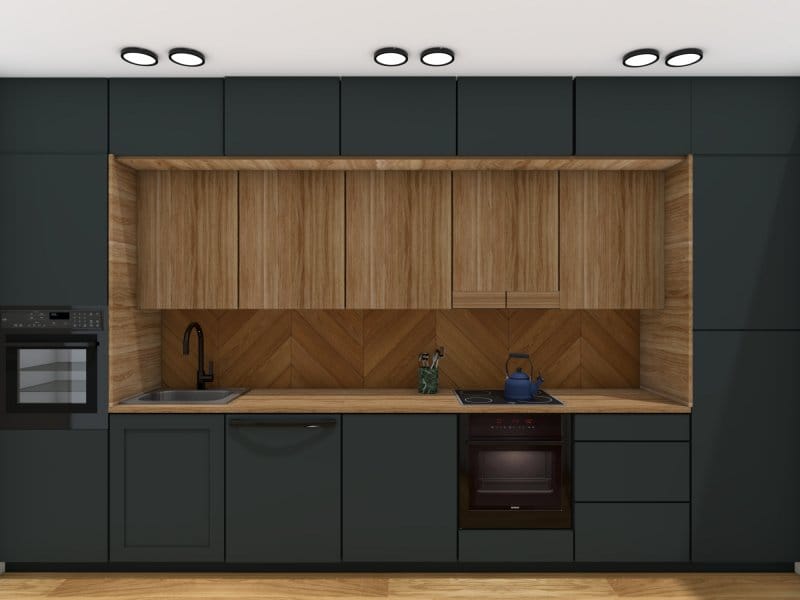
It's not just a trend; it's a solution for maximizing efficiency without sacrificing style. But like any design concept, it comes with its own set of rules. In this article, we'll delve into the essential do's and don'ts that will help you make the most of your one-wall kitchen layout.
The Do's
1. Maximize vertical space
One of the key advantages of a one-wall kitchen is its potential for vertical storage. In a layout where horizontal space might be limited, it's crucial to think upward. Wall storage options like mounted spice racks, magnetic knife strips, and pegboards can make a world of difference. These solutions provide easy access to your most-used items and add an element of visual interest to the wall.
Floating shelves and tall cabinets are other excellent ways to capitalize on vertical real estate. Floating shelves offer a sleek, modern touch while making it easy to display decorative dishes or keep essentials at arm's reach. Tall cabinets can be a game-changer for those bulky items or seldom-used kitchen gadgets, offering a concealed yet accessible storage option. By smartly utilizing the vertical space, you can make your one-wall kitchen look more expansive and function more efficiently.

2. Choose compact appliances
In a one-wall kitchen, every inch counts, and that's where compact appliances come into play. Opting for smaller, streamlined appliances can significantly impact how spacious your kitchen feels.
Think about under-counter refrigerators, slim dishwashers, or compact ovens designed to fit seamlessly into your layout without overwhelming the space. These appliances offer the same functionality as their full-sized counterparts but in a more space-efficient design.
Streamlined appliances not only save you precious floor space but also contribute to a cleaner, less cluttered look. This creates an open, airy feel, making your kitchen appear larger than it actually is. Plus, smaller appliances often come with the added benefit of being more energy-efficient. So, you're not just saving space, you're also cutting down on energy costs. It's a win-win solution that adds both aesthetic and functional value to your one-wall kitchen.
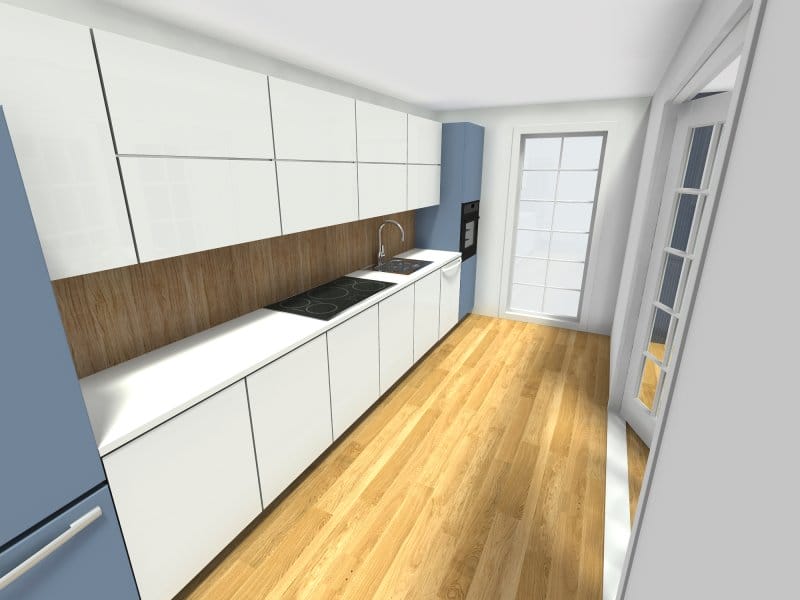
3. Opt for light colors
The color scheme you choose can have a profound impact on the ambiance of your kitchen, particularly in a one-wall layout where space is at a premium. Lighter shades are not just a design choice. They have psychological effects that can influence how you perceive the area.
Light colors like whites, creams, and soft pastels make a room feel brighter, larger, and more inviting. They reflect more light, thereby enhancing the sense of space. From a psychological standpoint, lighter colors are often associated with feelings of openness and cleanliness. They create an airy atmosphere that can make even the smallest of kitchens feel less cramped.
In contrast, dark colors tend to absorb light and can make a space feel more enclosed. So, when you're dealing with limited square footage, choosing a light color palette can be a strategic move to visually expand your kitchen and make it a more pleasant space to spend time in.
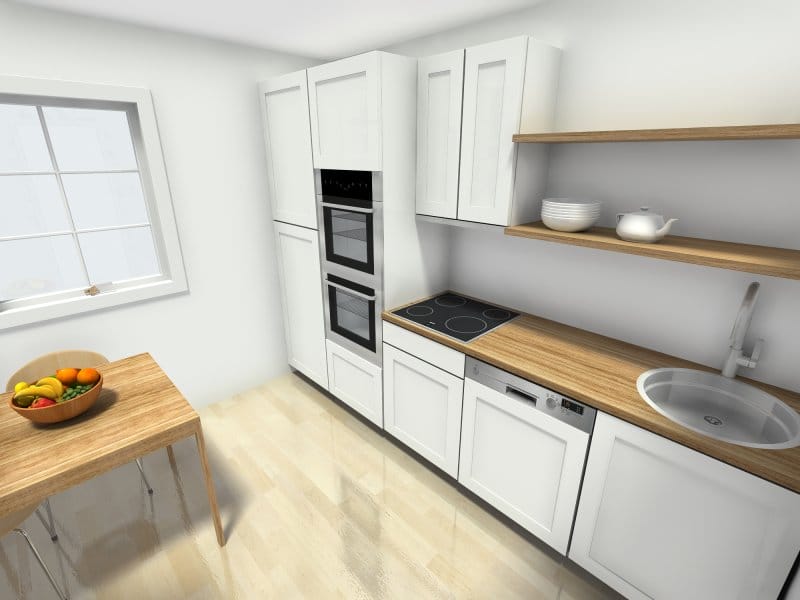
4. Incorporate multi-functional furniture
In a one-wall kitchen where space is a premium, multi-functional furniture can be your best friend. Pieces that serve more than one purpose not only save you room but also add a layer of convenience to your kitchen activities.
Take, for example, a rolling island. This versatile piece can serve as additional counter space for meal prep, offer extra storage with built-in drawers, and even act as a dining table when you add some stools. When not in use, you can simply roll it away to clear up floor space.
Other multi-purpose options include fold-down tables that can be stowed away when not needed or benches with built-in storage. These smart solutions allow you to maximize your space without sacrificing functionality or style. Choosing furniture that can adapt to different needs optimizes your one-wall kitchen for both efficiency and comfort.
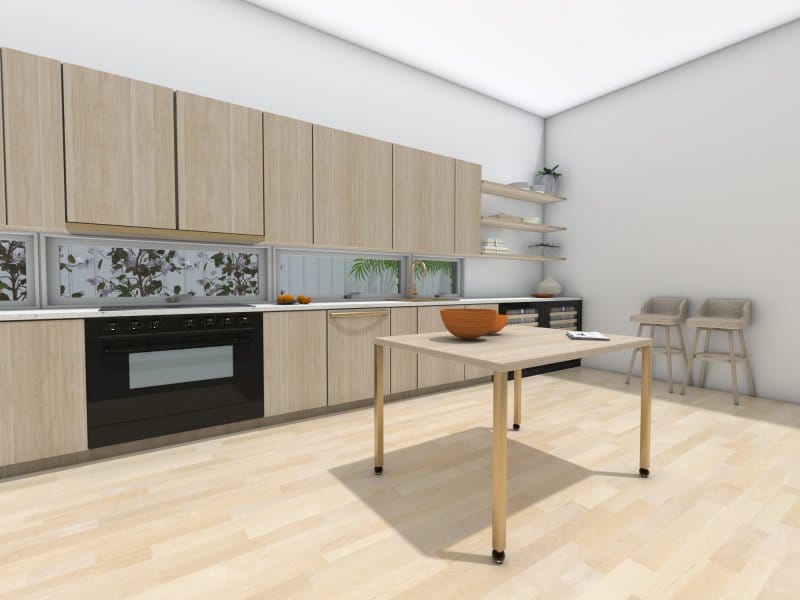
5. Prioritize workflow
In any kitchen, workflow is key, and the one-wall layout is no exception. While traditional kitchens often utilize the 'work triangle' concept—positioning the sink, stove, and refrigerator in a triangular arrangement for maximum efficiency—a one-wall kitchen requires a linear approach.
However, the essence of the work triangle can still be applied. Aim to place your most-used appliances and workstations in a logical sequence to minimize back-and-forth movement.
For instance, you might position the prep area near the sink, followed by the stove, and then the refrigerator. By thoughtfully arranging these core elements, you can create a streamlined workflow that allows for efficient meal preparation and cooking, even in a limited space.
Think of it as a 'work line' that guides your movements, making your kitchen tasks more intuitive and less strenuous. It's all about making the most of what you have and setting up your space to serve you, rather than the other way around.

The Don'ts
1. Overcrowd the space
One common pitfall in one-wall kitchens is the temptation to fill every available inch of space. While it may seem like a good idea to utilize all available room, doing so can quickly lead to a cluttered and chaotic environment.
A kitchen packed to the brim with gadgets, utensils, and decor can feel overwhelming, making it difficult to focus and operate efficiently. Less is often more when it comes to small spaces.
Instead of cramming in as many items as possible, aim for a balanced layout that gives each area room to breathe. Keep only the essentials within easy reach and use clever storage solutions for the rest. This creates a more visually appealing space and enhances your kitchen's functionality by making it easier to move around and complete tasks.
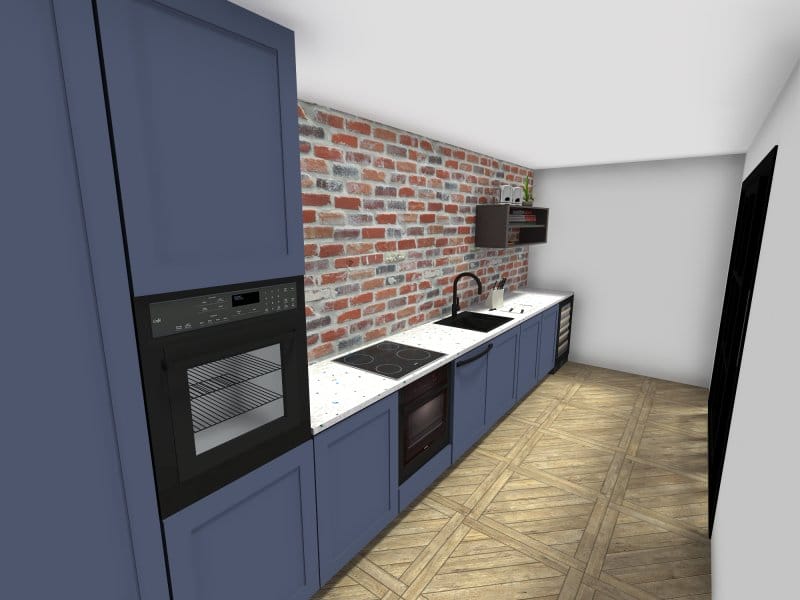
2. Neglect lighting
Lighting is often an overlooked element in kitchen design, especially in smaller layouts like the single-wall kitchen. However, well-placed lighting is crucial for both functionality and ambiance. Poorly lit spaces can make cooking tasks more challenging and can even be a safety hazard.
Conversely, a well-lit kitchen feels inviting and makes it easier to perform detailed tasks like chopping and reading recipes. In a one-wall kitchen, consider layering different types of lighting.
Task lighting under cabinets can illuminate your workspace, while pendant lights or a stylish fixture can add character and general illumination. Don't forget about accent lighting, like in-cabinet or toe-kick lights, to add depth and dimension.
A combination of these can make your kitchen not just functional but also a welcoming space where people want to gather.
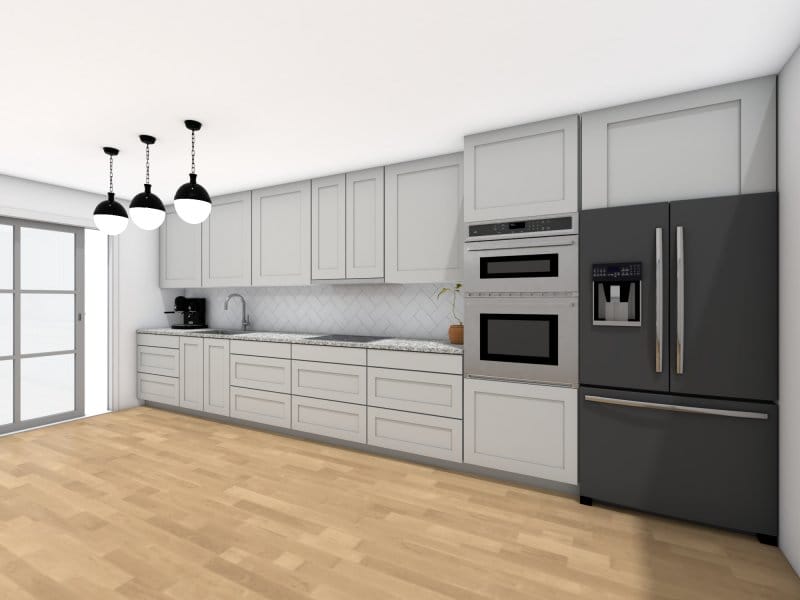
3. Ignore aesthetics
While functionality is key in a one-wall kitchen, aesthetics should not be ignored. A visually pleasing space is more enjoyable to spend time in and can even make cooking feel less like a chore. One common mistake is neglecting visual balance, which can result in a monotonous or cluttered look.
For example, placing all your tall items or heavy-looking cabinets on one end can throw off the balance and make the space feel disjointed.
To avoid a monotonous appearance, consider mixing different materials, textures, and colors. Perhaps incorporate open shelving between cabinets to break up the wall or use a standout backsplash to add a focal point. Adding a few decorative items or plants can also breathe life into the space.
By paying attention to these aesthetic details, you can create a one-wall kitchen that is functional and visually appealing.
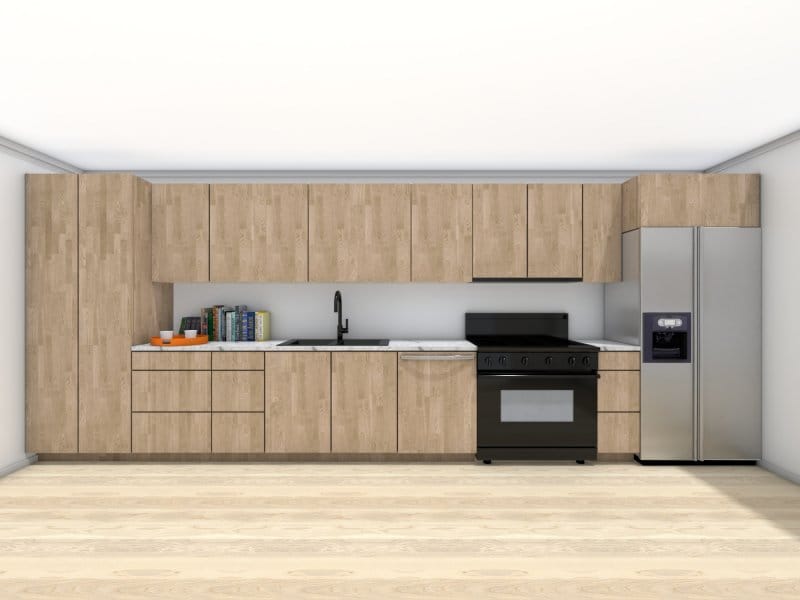
4. Skimp on quality
One might think that a smaller kitchen layout like the one-wall design means you can cut corners on quality—this couldn't be further from the truth. In fact, because the space is compact, each element plays a significant role and should be carefully considered. Using high-quality materials enhances the look of your kitchen and its durability and functionality.
Remember, cheaper materials might save you money upfront but can cost you more in the long run due to wear and tear or needed replacements. Investing in quality countertops, cabinetry, and appliances pays off by elevating the entire space and making it more enjoyable to use.
Quality materials, such as the countertop and flooring, are particularly important in high-traffic areas and surfaces that will endure regular use. In a small space, these details are more noticeable, and their impact is more significant.
Don't compromise on quality just because your kitchen is small. Make every square inch count!
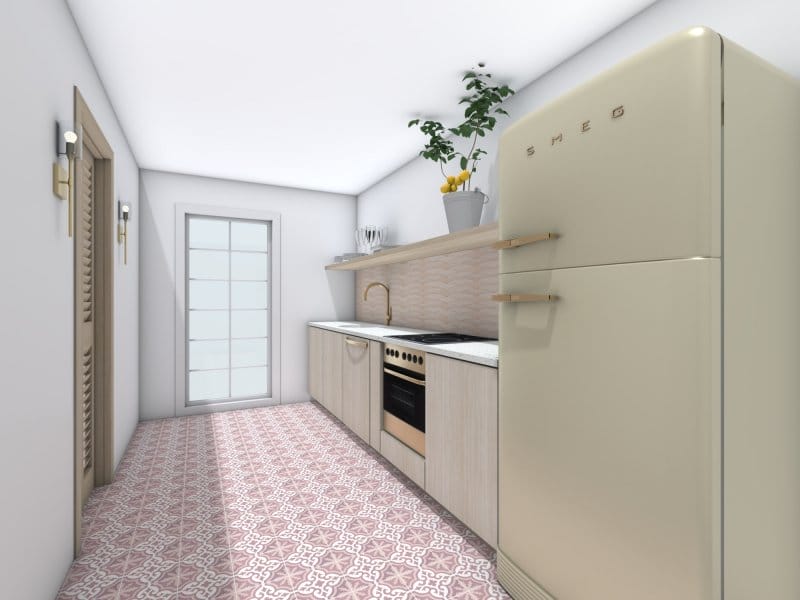
5. Underestimate planning
While a one-wall kitchen may seem simple to execute, the reality is that detailed planning is critical for making the most of your space.
The limited layout means each decision you make—from appliance placement to storage solutions—has a larger impact on functionality and flow. This is why consulting with a professional, even if it's just for a brief consultation, can provide invaluable insights.
However, if you'd prefer a DIY approach, you can use a kitchen planner like the RoomSketcher App to plan your single-wall kitchen layout. This specialized software allows you to visualize your space, make real-time changes, and even view your design in 3D.
Don't assume that because the space is small, you can wing it. A well-thought-out plan takes into account how you'll actually use the kitchen, ensuring that the layout serves your needs and lifestyle. Whether you opt for professional guidance or take advantage of planning tools like RoomSketcher, the more planning you do upfront, the smoother the installation process will be, and the more satisfied you'll be with your new one-wall kitchen.
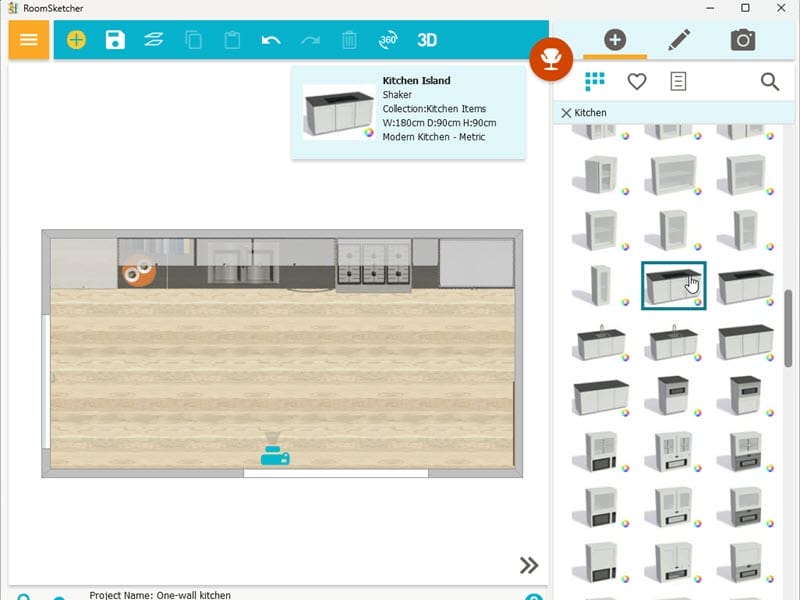
Create Your Own One-Wall Kitchen Layout
A one-wall kitchen layout offers a multitude of benefits, especially for smaller homes and apartments. It's a design that beautifully marries form and function, providing you adhere to this article's essential do's and don'ts.
Whether you're renovating or building from scratch, don't overlook this stylish and practical layout as a viable option. To bring your vision to life, consider using the RoomSketcher App. It's an intuitive tool that lets you plan, visualize, and even view your kitchen layout in 3D. With the right planning and attention to detail, your one-wall kitchen can be a space that's both efficient and aesthetically pleasing.
Don't forget to share this post!
Recommended Reads
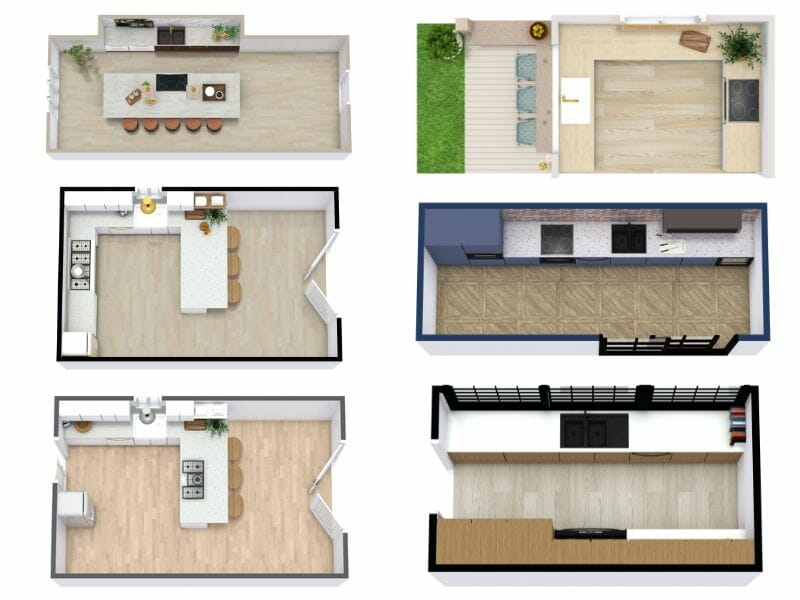
Kitchen Layouts 101 - The Complete Guide
In the heart of every home, the kitchen stands as a hub of creativity, nourishment, and connection. A well-designed kitchen layout is more than just a configuration of cabinets and appliances; it's a blueprint for a seamless culinary experience.
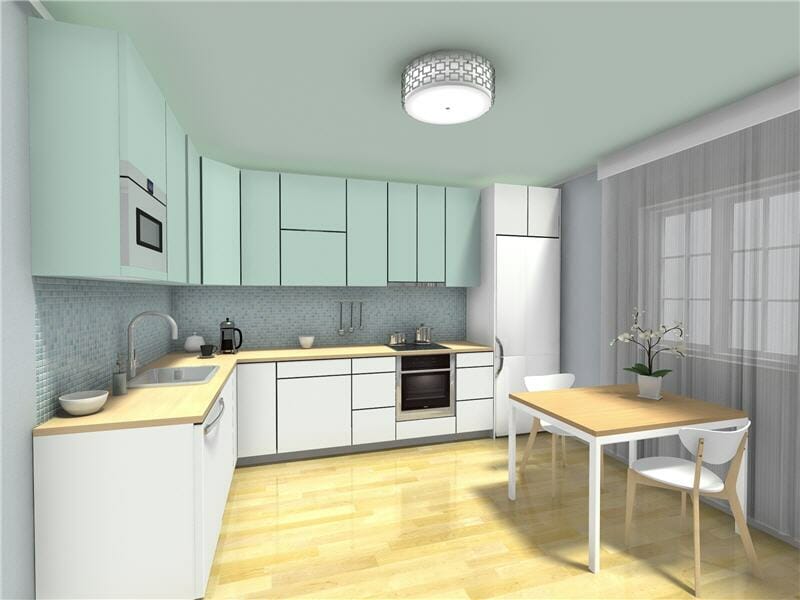
6 Tips to Think About When Designing an L-Shaped Kitchen Layout
We have put together 6 tips to help you create the perfect L-shaped kitchen layout.
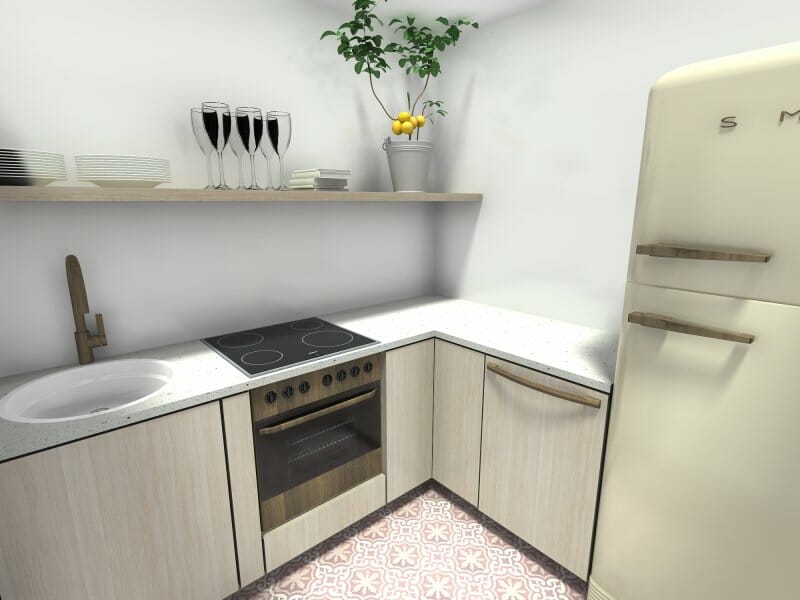
Make a Small Kitchen Layout Feel Bigger With Clever Design Tricks
Create kitchen floor plans in minutes with the easy-to-use RoomSketcher app and discover how to make a small kitchen layout feel bigger
